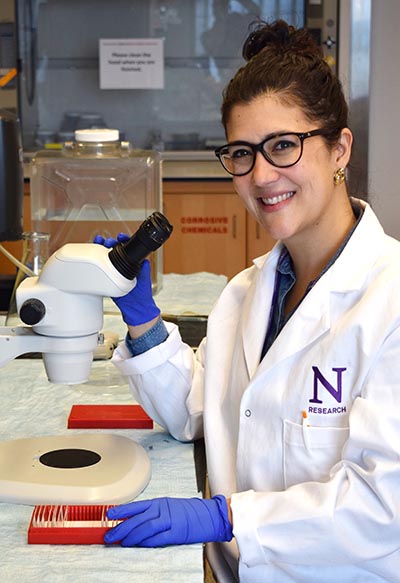CRN funding for projects, equipment boosts young researcher’s career
When Zaida Alvarez joined Samuel Stupp’s laboratory in 2015, the talented biologist from Spain quickly became a popular choice for research collaborations. But there was one problem — as a neurobiologist researching the ability of biomaterials to regenerate cells in the central nervous system, Alvarez was hindered by a lack of equipment. She didn’t have the proper binocular microscope to perform dissections, or even the tweezers necessary to extract tissues from the animals she was studying.
Fast forward several years, and the Simpson Querrey Institute for BioNanotechnology (SQI) and the Stupp group have access to all the instruments required to perform their own in vivo studies within the SQI animal surgery room. These purchases were all made possible by the Center for Regenerative Nanomedicine (CRN).
“Six years ago, we were only producing the materials, and now we are doing the whole project here at home,” Alvarez said. “Every time we want to do a small experiment now, we can do it here and we don’t have to wait on our collaborators to do it, so it gives you some freedom.”

After completing her undergraduate and doctorate degrees in Spain, Alvarez secured a pair of postdoctoral fellowships to support her first four years in the Stupp group — the Beatriu de Pinós Postdoctoral Fellowship (2015-2017) followed by the Paralyzed Veterans of America Postdoctoral Fellowship (2017-2019). She was then promoted in August 2019 to the position of Research Assistant Professor of Medicine at Northwestern and held that position for about two years before returning to Spain as a Ramón y Cajal Researcher at the Institute for Bioengineering of Catalonia. She remains a Visiting Scholar at SQI.
Alvarez has leveraged the opportunities offered by CRN perhaps as much as any young researcher since the center was founded. As of March 2022, she had coauthored 14 papers with the Stupp laboratory, including 11 related to CRN projects.
Alvarez highlighted four CRN-related publications in particular. The first three — a 2017 paper in Nature Communications and 2018 papers in Nano Letters and Science — detailed different approaches to signaling and manipulating cells in the central nervous system. Those efforts culminated in the biggest breakthrough of Alvarez’s career to date: a 2021 first-author paper in Science that described an injectable therapy that harnesses “dancing molecules” to reverse paralysis and repair tissue after severe spinal cord injuries.
The “dancing” effect comes from novel approaches to increase the motion of molecules within the injectable biomaterials, which also improves their efficacy. Alvarez said she knew the researchers were onto something once they began seeing positive results in the mouse models of spinal cord injury.
“We have observed for the first time that controlling the motion of molecules in nanoscale therapies can have a profound effect on their bioactivity, specifically in regenerative processes associated with spinal cord injury repair,” she said. “This novel result will greatly facilitate the translation of the technology to medicine.”
This discovery, led by Alvarez and Stupp, has generated news coverage in hundreds of media outlets worldwide and was the subject of the Rafael Hervada Award for Biomedical Research, which Alvarez received in February 2022.
She one day hopes to develop an independent research group of her own, but she’ll always have the CRN to thank for support during an important stage of her career.
“My plan is to continue researching how central nervous system injuries, like spinal cord injuries or traumatic brain injuries, can be treated with biomaterials,” Alvarez said. “I also want to experiment with adding exogenous cells or growth factors to biomaterials to increase their regenerative capacity.”
